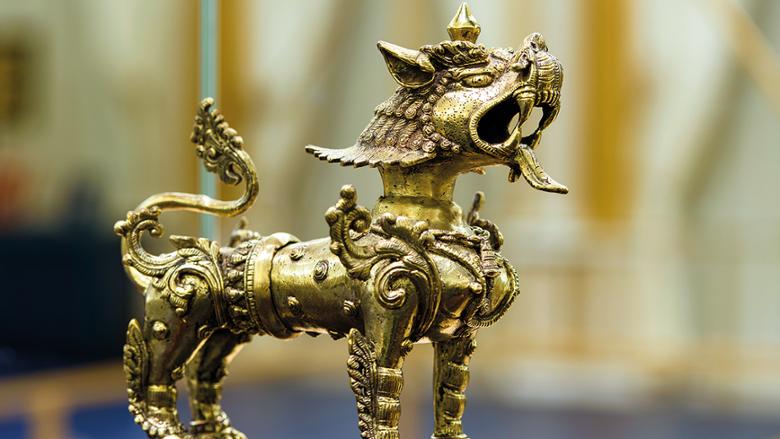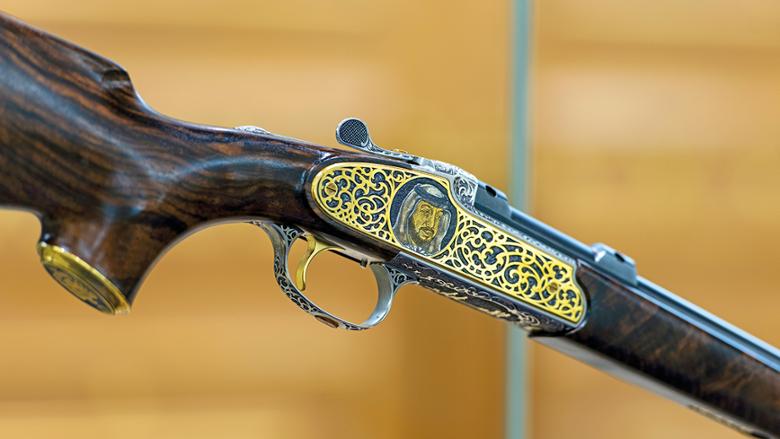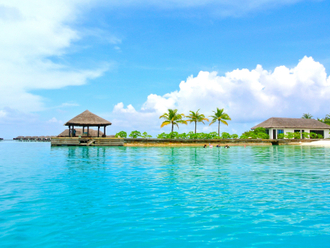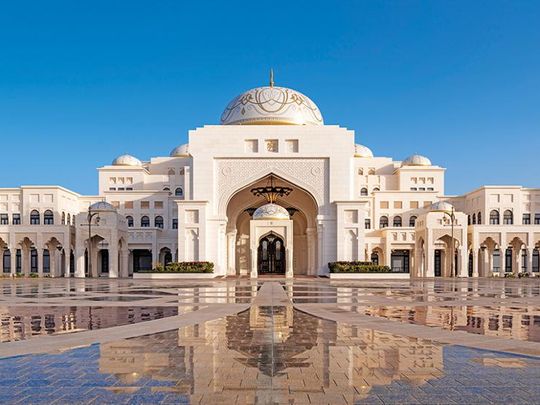
Nothing quite prepares you for the sheer opulence of Abu Dhabi’s new cultural landmark, Qasr Al Watan, which opened its doors to the public earlier this year. Not even its multi-domed, white exterior shimmering in the distance as you drive along the Corniche will prepare you for the breathtaking experience that awaits inside.
We begin our journey at the Visitor’s Centre, where we are treated to true Arabian hospitality with dates and coffee laced with a generous dose of saffron. A shuttle bus awaits to take us to the doorstep of Qasr Al Watan. As we draw closer, driving past lush courtyards, it is the understated elegance of the large domes with golden Arabesque calligraphy swirls that capture your attention. The sculptured gardens, fountains and delicately overflowing pools add to the distinctive charm of the place and silently welcome you in.
It is through an audio narration during this short bus journey that we learn that Qasr Al Watan, housed in the Presidential Palace compound, is not the private residence of the President of the UAE, but a working palace designed to host official state visits and summits. Several global leaders and heads of states have visited here since 2017, including the Pope.
[Sharjah's gateway to Islamic culture and art]
[In Hatta, a mountain village beckons wanderers]
Set amidst the 380,000-square-metre Presidential Palace compound, it also houses the formal offices of the UAE’s President, Vice-President and the Crown Prince of Abu Dhabi. More than a traditional palace, Qasr Al Watan is an exquisitely crafted tribute to the region’s Arabian heritage and artistry, says the narrator.
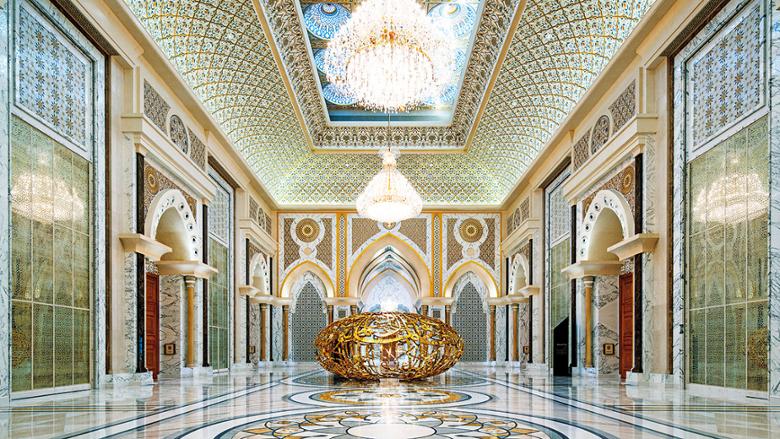
We are informed that the façade of the Palace is constructed from white granite and limestone built to last centuries, but which also more significantly reflects off the heat instead of absorbing it. The colour white was chosen as a symbol of purity and peace, and is also a reflection of the beige and white buildings that are commonly found in coastal Gulf countries.
As we step out, the arched colonnade characteristic of traditional houses in the Gulf region provide a respite from the heat. A massive wooden door featuring hand-carved designs opens to reveal a lavish spectacle that has to be seen to be believed. We hear gasps of awe from visitors at the first glimpse of the stunning interiors, featuring classical Islamic architectural motifs such as the arch, dome and ornate tile-work with interwoven patterns.
It is here that we meet our tour guide, who explains that the name Qasr Al Watan literally translates to ‘Palace of the Nation’, and it was constructed over a period of seven years from 2010 to 2017. The Presidential Palace, she adds, comprises the working offices of various government departments. Of these, only Qasr Al Watan is open to the public.
More than 5,000 unique geometric, vegetal and floral patterns inspired by the iconography and patterns of the Arab world can be seen in the palace, she tells us. ‘Solid maple wood has been chosen for the doors for their light colour and durability. The patterns have been carved by hand and each door took 350 man hours to make.’
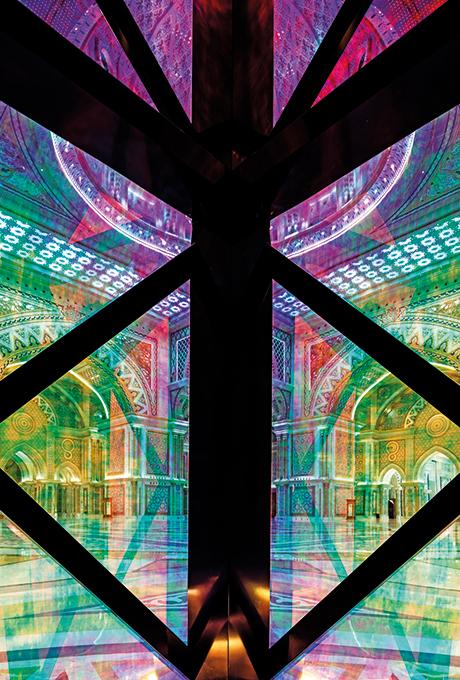
The key colours of the palace – white, blue and yellow – reflect the richness of the region’s landscape and allude to the dominant hues of the desert, sky and sea, she adds. ‘White is also symbolic of peace and coexistence, hallmarks of the UAE’s governing tradition. Together, this harmonious blend of hues gently breaks the uniformity of the décor and unites the overall design.’
We make our way to The Great Hall, which the narrator describes as the architectural heart of Qasr Al Watan. Measuring 100m x 100m, its impressive size makes it the centrepiece of the building. The crowning jewel here is the central dome, one of the largest in the world. Standing 60 metres above the ground – the height of a seven-storey structure, the dome has a diameter of 37 metres, and features 12 large double curved glass panels.
High above on the dome are stained glass windows, each measuring 170cm x 350cm and weighing approximately 250kg. The light passing through these illuminates the space. ‘The process of staining glass is a very old technique that entails a high level of craftsmanship,’ explains our guide. ‘Each drawing or cutting is by itself a piece of art.’
Four art installations of mirrored cubes placed inside The Great Hall showcase its stunning architectural design, diversity of patterns, and intricate craftsmanship from a variety of perspectives.
The foundation of the Palace’s interior is the eight-pointed star, an important symbol in Islam that consists of two overlapping squares, where one square is turned at 90 degrees, says our guide. ‘This symbol is used in Arabic calligraphy to mark a chapter’s end and appears in the Holy Quran at the end of passages,’ she explains. Indeed, the eight-point star is a recurring motif that runs through Qasr Al Watan, right from its appearance in various forms and patterns across the courtyard and gardens, to its majestic hallways and ornate ceilings.
We move towards the West Wing and pause to admire the beauty of precision of the symmetrical patterns found throughout the Palace, which are a key characteristic of Arabian architecture. ‘It was the constraints of using human or animal figures in Islam that led to the evolution of the art form of geometric patterns in Arab architecture for ornamentation purposes,’ she says. ‘Though they look elaborate and complex, the patterns are based on simple grids and are a testament to the aesthetics of the craftsmen and their extraordinary skills.’
At Qasr Al Watan, mirror image marble slabs are placed side by side creating impactful designs in a process known as a book matched marble technique. ‘Only highly experienced artisans know how to find blocks of marble suitable for this ancient technique,’ explains our guide, drawing our attention to some excellent examples on the walls. It appears that every line, pattern and grain in the marble floors and walls has its own story to recount.
She also points out muqarnas, a distinctive ornamentation that produces a decorative honeycomb effect and is chiefly used to form smooth transitions between straight walls and domed spaces. ‘Muqarnas were used frequently in older structures in the UAE and their usage here contributes to this legacy,’ she says.
We also notice how the patterned composition of the delicate mashrabiya, a traditional Islamic window element with its characteristic latticework, allows natural light to filter into the Great Hall.
Our guide leads us to the Presidential Gifts exhibition to see some of the artefacts exchanged during diplomatic engagements. ‘When choosing official gifts, the three main things that are taken into consideration are culture, religion, and personal taste,’ she says, as we admire the decorative vases from the Orient, and fine sculpture from Europe.
The Korean moon jar, a gift from the Republic of Korea, has a uniquely plain and simple design that is starkly different from the decorated pottery found around the world. As part of the Japanese collection is the Samurai Armour, while a collection of falcon masks have been gifted by the Federal Republic of Germany.
A treasured gift here is a falcon carved from a single piece of glass by Baccarat, the legendary French manufacturer of fine crystal glassware.
We then step into the Spirit of Collaboration room, which has been designed as a space of leadership, cooperation and governance, and is used to host the meetings and summits of local, regional and international counsels. ‘The circular layout of this room was influenced by the dome above and suggests egalitarianism, she says.
Suspended from the 23-carat gold leaf-lined dome is a magnificent chandelier with 350,000 crystals that is so large, it had to be assembled in this room and even has space inside for a person to carry out repairs. Apart from its striking beauty, the chandelier also serves a practical purpose – to absorb sound in the amphitheatre-style room, which can hold around 900 people, she adds.
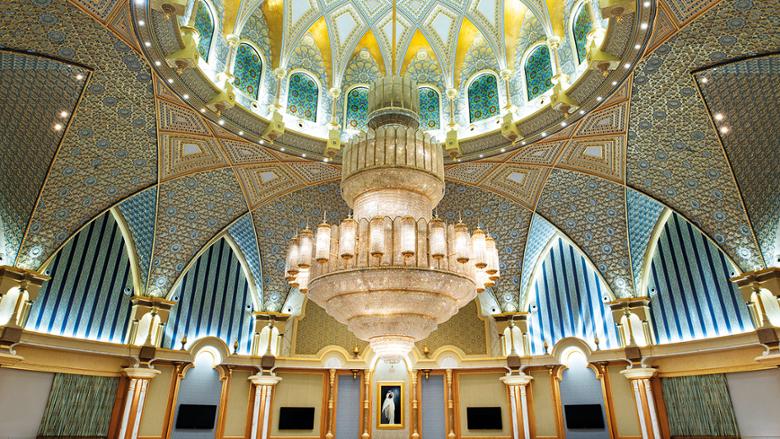
The Presidential Banquet Hall reserved for state banquets and which can host up to 300 guests at a time also pays tribute to the Emirati culture of hospitality. ‘Food served here reflects the guests’ culture, and in keeping with the protocol of a state banquet, the guest of honour is always seated to the right of the host,’ says our guide. ‘The circular tables in front of the official table always stay half-empty so that guests are not seated with their backs to the host and other dignitaries.’
Tables here are set with hand-painted bone china plates, crystal ware and silverware custom-made for the Palace.
Within the House of Knowledge in the east wing, we come upon an impressive collection of artefacts and manuscripts that highlight origins of libraries in the Arab world and its contributions to various intellectual fields including science, arts, humanities and literature. Here we see one of the earliest modern maps of Arabia by the Italian cartographer Giacomo Gastaldi, dated 1561, with the names of Abu Dhabi, Dubai and other prominent emirates written in precisely the same manner that it is said in Arabic. It uses information gathered by Portuguese explorers and is thought to be the earliest map to name Abu Dhabi.
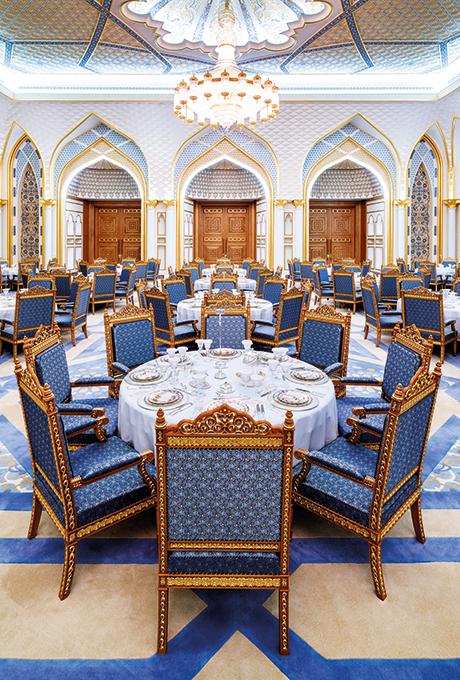
‘The exhibition at the House of Knowledge showcases the Arab contributions to human knowledge in the period of enlightenment known as the Arab Golden Age, which traditionally dates from the mid eighth century to the mid 13th century,’ explains our guide.
We learn about the Arab pioneers in medicine; discover the advances made in astronomy and navigation; observe the evolution of calligraphy from Kufic, the first script to gain prominence in Arabic calligraphy to Cursive, which later became the standard script; and are impressed by the Arab contributions in literature which gave us the inimitable Arabian Nights (One Thousand and One Nights) that has captivated the imagination of readers for centuries.
Found here are also the oud and ganun, musical instruments responsible for some of the unique soundscapes found in traditional Arabic music.
In honour of the 2019 UAE Year of Tolerance, three holy books – the Holy Quran, the Holy Bible and the Book of David’s Psalms are displayed together.
We step out of the House of Knowledge to marvel at the lattice-inspired gold sculpture by Emirati artist Mattar Bin Lahej that pays homage to the leadership values exemplified by the late Shaikh Zayed Bin Sultan Al Nahyan featuring an interlaced inscription of his famous quote: ‘Wealth is not money or oil; wealth lies in people and it is worthless if not dedicated to serve the people.’
Our visit comes to an end at the Qasr Al Watan Library, an architectural marvel with a soaring atrium, housing a treasure trove of knowledge resources in the fields of science and the arts in the UAE, collected over a period of 35 years. There are also books on archaeology, history, memoirs, biographies, culture and literature.
Know before you go
A general admission ticket is Dh60; children under 17 pay half price. Timings are 10am to 8pm, daily.
Guided tours run for one hour and cost Dh30 per person. Held every 30 minutes, tours are available in English, Arabic, Mandarin and Russian. Private tours are available on request and cost Dh600 for up to 20 visitors. For more info and to buy tickets, visit qasralwatan.ae.


